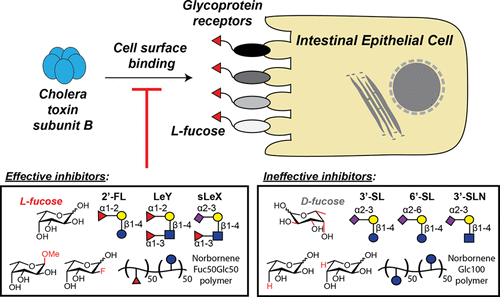当前位置:
X-MOL 学术
›
ACS Infect. Dis.
›
论文详情
Our official English website, www.x-mol.net, welcomes your feedback! (Note: you will need to create a separate account there.)
Fucosylated Molecules Competitively Interfere with Cholera Toxin Binding to Host Cells
ACS Infectious Diseases ( IF 5.3 ) Pub Date : 2018-02-07 00:00:00 , DOI: 10.1021/acsinfecdis.7b00085 Amberlyn M. Wands , Jakob Cervin 1 , He Huang 2 , Ye Zhang 2 , Gyusaang Youn 2 , Chad A. Brautigam , Maria Matson Dzebo 3 , Per Björklund 4 , Ville Wallenius 4 , Danielle K. Bright 5 , Clay S. Bennett 5 , Pernilla Wittung-Stafshede 3 , Nicole S. Sampson 2 , Ulf Yrlid 1 , Jennifer J. Kohler
ACS Infectious Diseases ( IF 5.3 ) Pub Date : 2018-02-07 00:00:00 , DOI: 10.1021/acsinfecdis.7b00085 Amberlyn M. Wands , Jakob Cervin 1 , He Huang 2 , Ye Zhang 2 , Gyusaang Youn 2 , Chad A. Brautigam , Maria Matson Dzebo 3 , Per Björklund 4 , Ville Wallenius 4 , Danielle K. Bright 5 , Clay S. Bennett 5 , Pernilla Wittung-Stafshede 3 , Nicole S. Sampson 2 , Ulf Yrlid 1 , Jennifer J. Kohler
Affiliation

|
Cholera toxin (CT) enters host intestinal epithelia cells, and its retrograde transport to the cytosol results in the massive loss of fluids and electrolytes associated with severe dehydration. To initiate this intoxication process, the B subunit of CT (CTB) first binds to a cell surface receptor displayed on the apical surface of the intestinal epithelia. While the monosialoganglioside GM1 is widely accepted to be the sole receptor for CT, intestinal epithelial cell lines also utilize fucosylated glycan epitopes on glycoproteins to facilitate cell surface binding and endocytic uptake of the toxin. Further, l-fucose can competively inhibit CTB binding to intestinal epithelia cells. Here, we use competition binding assays with l-fucose analogs to decipher the molecular determinants for l-fucose inhibition of cholera toxin subunit B (CTB) binding. Additionally, we find that mono- and difucosylated oligosaccharides are more potent inhibitors than l-fucose alone, with the LeY tetrasaccharide emerging as the most potent inhibitor of CTB binding to two colonic epithelial cell lines (T84 and Colo205). Finally, a non-natural fucose-containing polymer inhibits CTB binding two orders of magnitude more potently than the LeY glycan when tested against Colo205 cells. This same polymer also inhibits CTB binding to T84 cells and primary human jejunal epithelial cells in a dose-dependent manner. These findings suggest the possibility that polymeric display of fucose might be exploited as a prophylactic or therapeutic approach to block the action of CT toward the human intestinal epithelium.
中文翻译:

岩藻糖基化分子竞争性干扰霍乱毒素与宿主细胞的结合。
霍乱毒素(CT)进入宿主肠道上皮细胞,其逆行转运到细胞质中导致大量液体和电解质大量流失,并伴有严重的脱水。为了启动这种中毒过程,CT(CTB)的B亚基首先与显示在肠上皮顶表面上的细胞表面受体结合。虽然单唾液酸神经节苷脂GM1被广泛接受为CT的唯一受体,但肠上皮细胞系还利用糖蛋白上的岩藻糖基化聚糖表位来促进细胞表面结合和毒素的内吞摄取。此外,1-岩藻糖可以竞争性地抑制CTB与肠上皮细胞的结合。在这里,我们使用竞争性结合与试验升-岩藻糖类似物,以破译l-岩藻糖抑制霍乱毒素亚基B(CTB)结合的分子决定因素。此外,我们发现单和双岩藻糖基化低聚糖是比l更有效的抑制剂。-单糖,其中LeY四糖成为结合两种结肠上皮细胞系(T84和Colo205)的最有效的CTB抑制剂。最后,当针对Colo205细胞进行测试时,一种非天然的含岩藻糖聚合物比LeY聚糖更有效地抑制CTB结合两个数量级。该相同的聚合物还以剂量依赖的方式抑制CTB与T84细胞和原代人空肠上皮细胞的结合。这些发现表明,岩藻糖的聚合物展示可能被用作预防或治疗CT阻断人肠上皮细胞作用的可能性。
更新日期:2018-02-07
中文翻译:

岩藻糖基化分子竞争性干扰霍乱毒素与宿主细胞的结合。
霍乱毒素(CT)进入宿主肠道上皮细胞,其逆行转运到细胞质中导致大量液体和电解质大量流失,并伴有严重的脱水。为了启动这种中毒过程,CT(CTB)的B亚基首先与显示在肠上皮顶表面上的细胞表面受体结合。虽然单唾液酸神经节苷脂GM1被广泛接受为CT的唯一受体,但肠上皮细胞系还利用糖蛋白上的岩藻糖基化聚糖表位来促进细胞表面结合和毒素的内吞摄取。此外,1-岩藻糖可以竞争性地抑制CTB与肠上皮细胞的结合。在这里,我们使用竞争性结合与试验升-岩藻糖类似物,以破译l-岩藻糖抑制霍乱毒素亚基B(CTB)结合的分子决定因素。此外,我们发现单和双岩藻糖基化低聚糖是比l更有效的抑制剂。-单糖,其中LeY四糖成为结合两种结肠上皮细胞系(T84和Colo205)的最有效的CTB抑制剂。最后,当针对Colo205细胞进行测试时,一种非天然的含岩藻糖聚合物比LeY聚糖更有效地抑制CTB结合两个数量级。该相同的聚合物还以剂量依赖的方式抑制CTB与T84细胞和原代人空肠上皮细胞的结合。这些发现表明,岩藻糖的聚合物展示可能被用作预防或治疗CT阻断人肠上皮细胞作用的可能性。



























 京公网安备 11010802027423号
京公网安备 11010802027423号